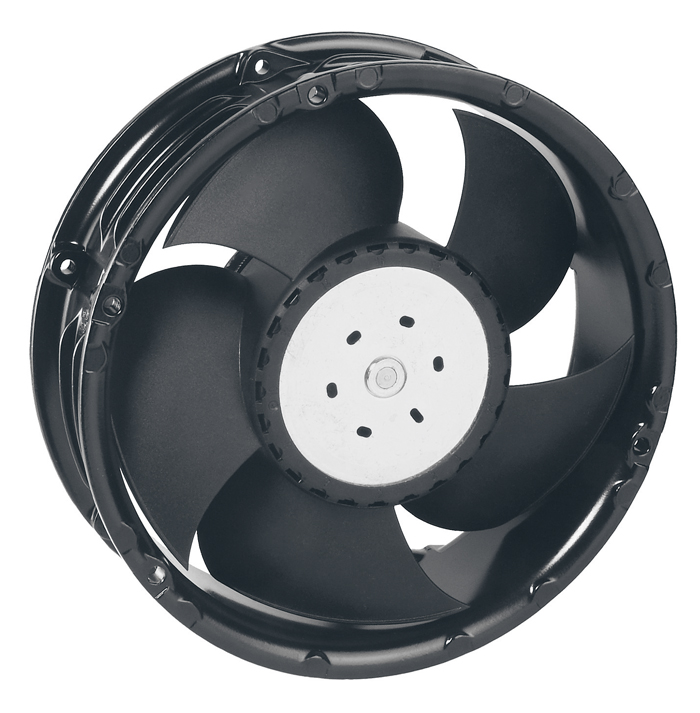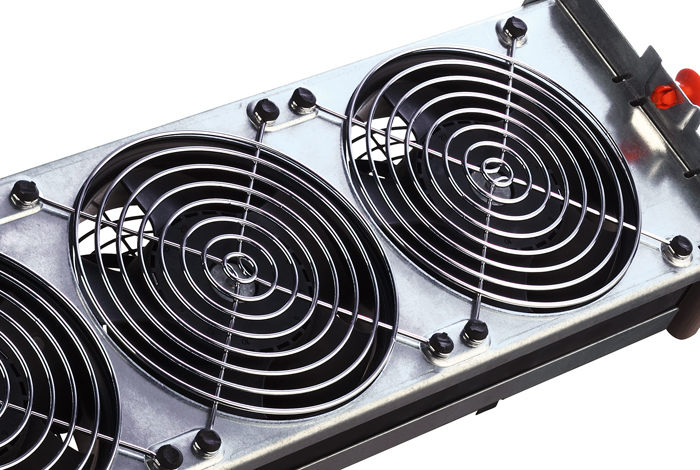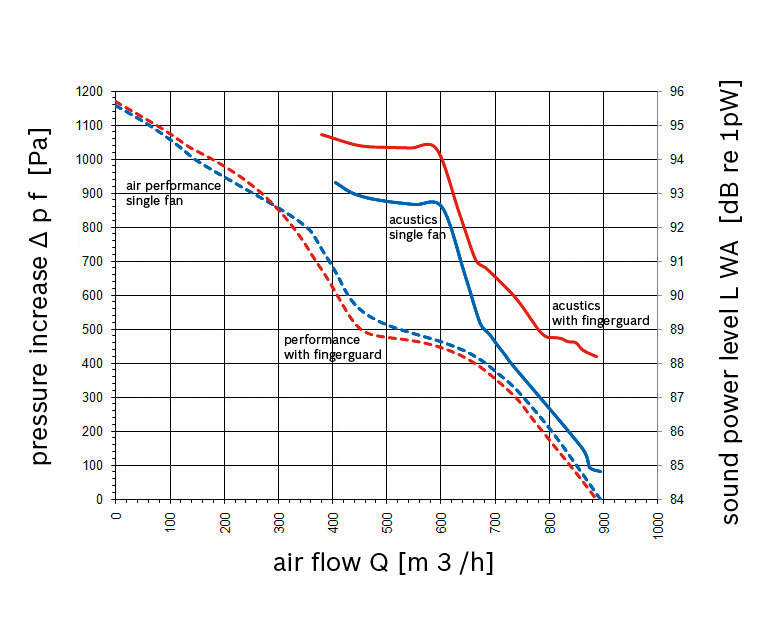Fans are part of the standard equipment in almost all industrial facilities today. They cool, suction, regulate humidity and do much more. The benefit is plain to see, but compact dimensions and high blower output with low power consumption also bring some limitations to safety. A standard fan today runs at a relatively high speed. The fact that the bearings move easily means that the fan has a long run-down time when shut off. Since rotating parts always entail danger of injury, safety is guaranteed via guard grilles. These, however, cause aerodynamic disadvantages. A new approach that avoids these disadvantages with a greater level of safety is an active brake in the fan. If the fan gets switched off, the wear-free electronic brake reduces the run-down time to less than two seconds. The kinetic energy is quickly dissipated, thereby drastically reducing the risk of injury.

Figure 1: The new fan with integrated Action-Brake is just as compact as the conventional models
Rotating masses store energy. This property, which is desired in flywheels, becomes a source of danger in other rotors. This also applies to fans whose rotors transfer the energy of the motor to the air through blades. Large volumes of air can be moved at high speeds, even with compact dimensions. Simultaneously, however, the energy stored in the impeller also increases, and with it the potential hazard. For protection, the fan specialist ebm-papst from St. Georgen now provides – in addition to guard grilles – a new, aerodynamically better alternative: ActionBrake, the active brake integrated in the fan motor. In less than two seconds it reduces the speed to harmless values without requiring additional installation space or generating additional drag, as with a guard grille (Figure 1). By way of comparison, a standard fan without a brake requires 20 seconds to reduce the speed to harmless values.
State of the art of technology

Figure 2 (left): Clearly visible, guard grilles not only stand out visually, they also impede the air flow
If a service technician switches a device off and opens it, the rotating rotors of the fans pose a substantial potential hazard. This applies particularly to modern compact fans, which operate at high speeds in order to overcome high counterpressure or to generate a large air flow. At the same time, low-friction bearings operate in the fans to increase the energy efficiency and service life. Consequently, the energy stored in the rotor makes for long run-down times. If the rotation is suddenly stopped by an object or even a finger, the kinetic energy abruptly discharges. This leads to damage or, in the worst case, injury. To prevent this, regulations stipulate the use of protection against accidental contact with quickly accessible fans, in other words, guard grilles (Figure 2). Precisely with high-peformance fans, however, this negates a portion of the sophisticated aerodynamic properties. The grille generates turbulence and thereby noise and counterpressure, resulting in lower blower output. Thus the grille acts as an energy dissipator, like a gently and continuously applied brake. The higher speed here generates even more additional noise (Table 3a, Figure 3b).
Safety without external components

Table 3a: Comparison of Sound Power Level; Fans with and without a guard grille
The new approach proceeds from integrated rapid braking via the fan drive. This means that no more disruptive obstructions are implemented in continuous operation; the fan can operate at optimum efficiency. This also reduces installation effort and eases the installation. The principle behind the wear-free brake is simple as well as tried-and-tested: The motor becomes a generator and the generated current is then converted into heat. The technology offers various options for the design. Higher outputs require external brake resistors; small outputs use the motor windings as a brake resistor by means of a short-circuit switch. Therefore the fan experts were set the task of optimally designing the ActionBrake to meet the needs of the fans, while doing without external components wherever possible. Through a series of tests, the optimum variant was found to be the short-circuit switch for the motor windings. Initially in this case, however, very large currents can arise at high speeds by means of the induction. This means that the windings have to endure a high but short-term heat load, and the control transistors have to be designed for these pulse currents. Additionally, high currents in coils always means there will be a strong (counter) magnetic field. Thus there is a danger of the magnets in the rotor demagnetising. These problems are solved by a suitable selection of components and configuration of the magnets. Therefore the brake lifting magnet operates as reliably and as long as usual.

Figure 3b: Comparison of characteristic curve; Fans with and without a guard grille
If the operating voltage is switched off, the electronics enter the braking mode. In doing so, they draw their power supply from the loaded filter capacitor. If the voltage decreases, the capacitor is recharged by short charging pulses from the “brake generator”. This is done to maintain the function, and thus the activation of the short-circuit transistors of the electronics, until the rotor comes to a standstill. To do so, the brake short circuit is temporarily disconnected. With a typical fan, this enables braking times of under three seconds. The inner heat capacity of the components and the maximum braking energy then produce a temperature level that reliably lies below the maximum operating temperature of the components used. This ensures long-time operation that is free of malfunctions and maintenance. The new active braking upon switching off the power supply at the fan opens new options to the user. In short, the brake lifting magnet brings a whole series of benefits all at once: elimination of guard grilles and their installation, which translates into less noise, better output and lower costs by means of lower power consumption. Also in terms of logistics, the lower number of parts is a noticeable plus. Thus the new brake lifting magnets save time and money while maintaining the level of safety.





Leave a comment